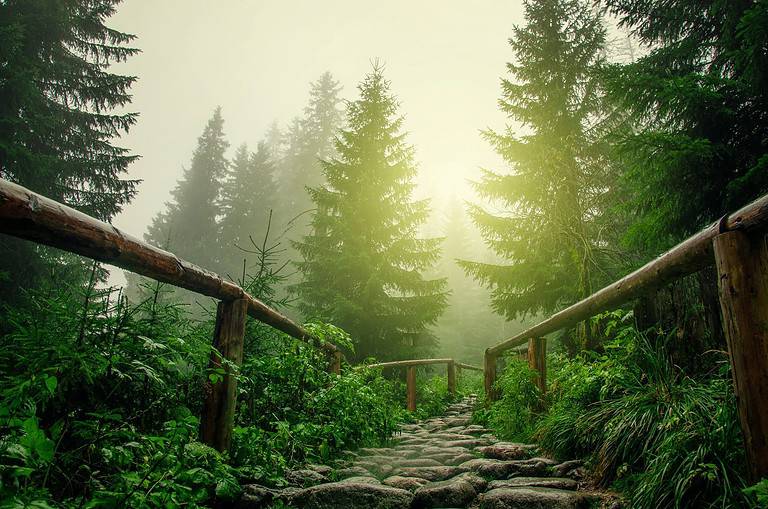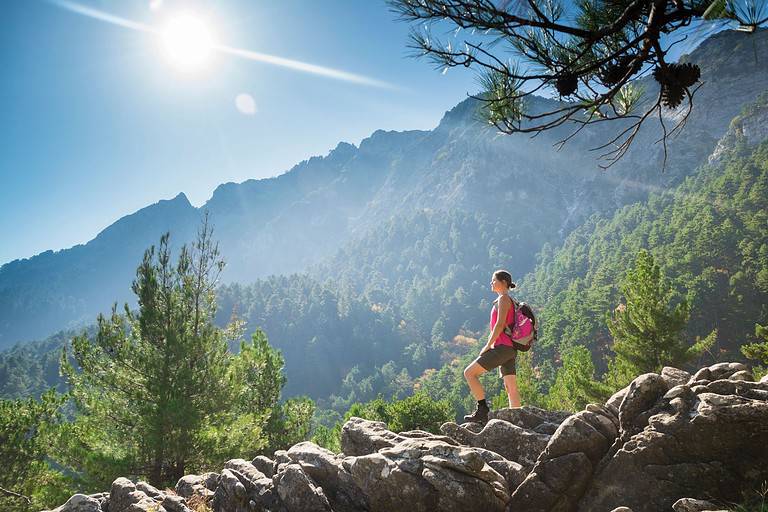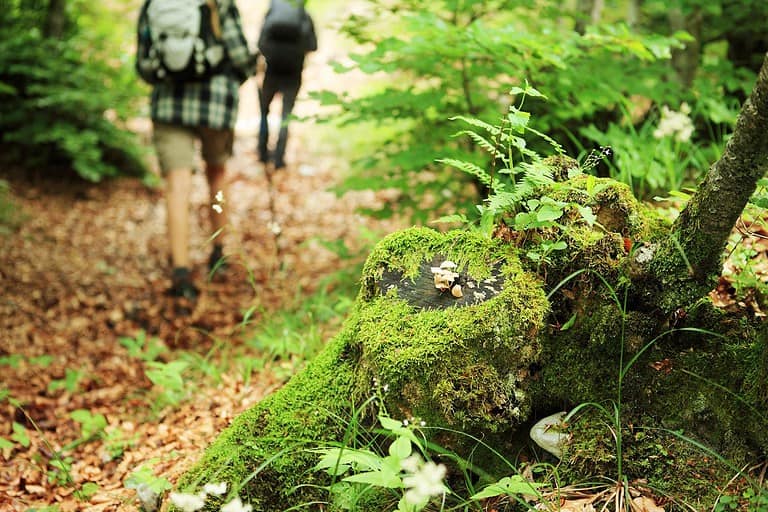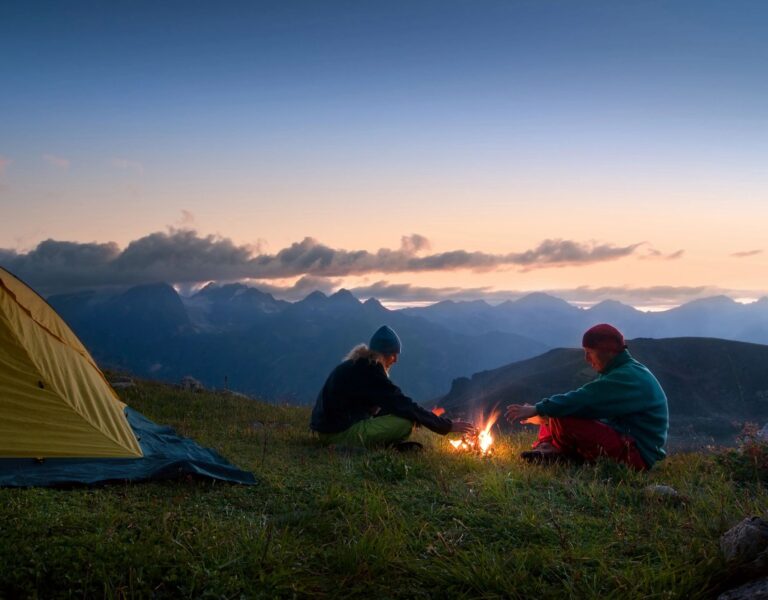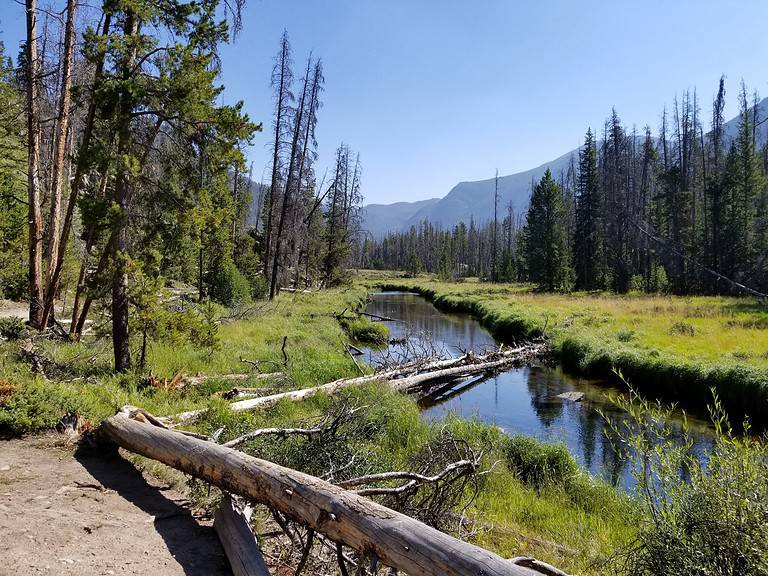100 Best Bucket List Hiking Trails-20 National Parks
What is Our Hiking Bucket List?
We are avid hikers who love nothing more than exploring the incredible diversity of U.S. National Parks. We’re in the process of ticking off the top 100 hiking trails across these parks and we’re excited to share our bucket list with you.
Our list includes hikes across a variety of landscapes – from the high peaks of the Rockies to the dense forests of Olympic, and from the unique deserts of Utah to the stunning coastlines of Acadia. Each one offers its own unique experience and breathtaking views.
We were able to do several of the parks and hikes in a unique way. We took the Amtrak from Chicago across to Washington state, down the California coast, and back across the country through Colorado back to Chicago. We hiked in five national parks and saw scenery that could only be seen by train. The Amtrak pass was very affordable and was for 60 days.
Just remember, some of these hikes can be challenging and require proper preparation. It’s important to understand the demands of each trail, to check weather conditions, and to make sure you’ve got the right gear. Preparation is key to ensure your hiking experience is both safe and enjoyable.
So, let’s lace up our boots, hit the trail, and experience these amazing national parks together.
How Many National Parks Are There?
There are 424 National Park Sites according to the National Park Foundation. Of these 63 have ‘National Park’ as part of their proper name. The National Park system covers 84 million acres with parks in each state.
| National Parks | 63 |
| National Parkways | 4 |
| National Historic Sites | 74 |
| National Lakeshores | 3 |
| National Preserves | 19 |
| National Reserves | 2 |
| National Recreation Areas | 18 |
| National Rivers | 4 |
| National Scenic Trails | 3 |
| National Seashores | 10 |
| National Wild & Scenic Rivers and Riverways | 10 |
| National Memorials | 31 |
| National Monuments | 83 |
| National Memorials | 31 |
| National Battlefields | 11 |
| National Battlefield Site | 1 |
| National Military Parks | 9 |
| National Battlefield Parks | 4 |
| International Historic Sites | 1 |
| Other Designations | 11 |
How Many People Hike Each Year?
- There are around 57.8 million hikers in the US.
What Is the National Trail System?
- consists of around 193,000 hiking miles.
- includes 200,000 miles of trails located on federal lands.
- has been very beneficial allowing for 9 million backpackers and 8 million mountain bikers on the trails alongside hikers
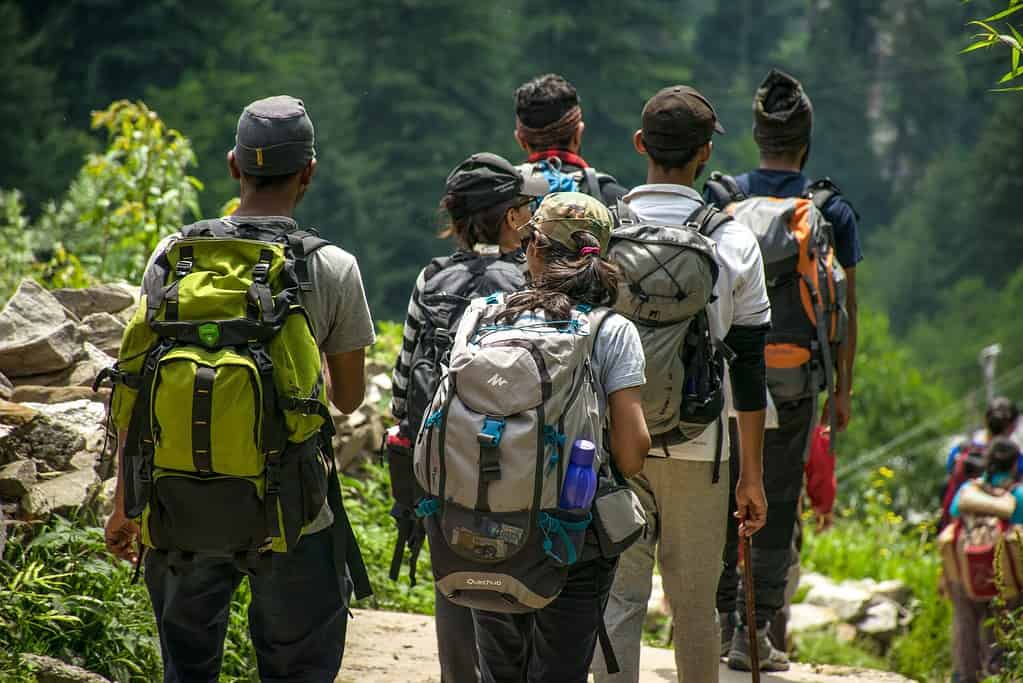
What Are The Best Hiking Trails?
1. Yellowstone National Park
America’s first national park, famous for its geysers, hot springs, and wildlife.
Yellowstone National Park, located primarily in the U.S. state of Wyoming, is a nature enthusiast’s paradise and a hub of geothermal activity. It is the first National Park in the U.S. and is widely held to be the first national park in the world.
Covering an area of over 2.2 million acres, Yellowstone is famed for its vibrant hot springs, geysers, and mud pots, with the iconic Old Faithful Geyser being one of its most popular attractions. It sits on top of a volcanic hot spot, which accounts for its significant geothermal activity.
But the park isn’t just geysers and hot springs. It’s a place of unparalleled natural beauty with rugged mountains, verdant forests, vast meadows, deep canyons, and large high-altitude lakes. The Grand Canyon of Yellowstone is known for its picturesque waterfalls and colorful rocky walls.
Yellowstone is also a wildlife watcher’s dream come true. It is home to the largest concentration of animals in the Lower 48 states, including grizzly bears, wolves, elk, and bison. Its waters teem with trout and other freshwater fish.
Apart from wildlife viewing, the park offers numerous recreational opportunities, such as hiking, fishing, camping, boating, snowshoeing, and cross-country skiing in winter.
Yellowstone National Park allows visitors to explore a diverse and dynamic ecosystem with many wonders and natural beauty.

Trails & Activities
Hiking Trails:
Activities:
| Trail | Length (miles) | Elevation (ft) | Difficulty | Type |
| Mt Washburn | 6.8 | 1394 | Moderate | Out & Back |
| Fairy Falls | 4.8 | 170 | Easy | Out & Back |
| Yellowstone River Picnic Area | 3.9 | 456 | Easy | Loop |
| Lone Star Geyser | 5.3 | 127 | Easy | Out & Back |
| Mystic Falls | 2.4 | 147 | Easy | Out & Back |
2. Glacier National Park
Renowned for its glacier-carved peaks and valleys.
Glacier National Park, located in the U.S. state of Montana, is a sprawling expanse of over one million acres that shares a border with Canada’s Waterton Lakes National Park. The park is often referred to as the “Crown of the Continent” due to its pristine ecosystem and rugged, awe-inspiring beauty.
The park is known for its diverse landscape that ranges from green forests and alpine meadows to glistening lakes and towering peaks, some of which still hold remnants of ancient glaciers. It’s home to over 130 named lakes, numerous waterfalls, and two major river systems.
The Going-to-the-Sun Road, a 50-mile scenic drive across the park, provides visitors with breathtaking views of the park’s majestic landscapes. The park also boasts more than 700 miles of trails, making it a hiker’s paradise. The trails cater to all skill levels, from casual strolls along glacial lakes to challenging high-altitude treks.
The park is also renowned for its diverse plant life, grizzly bears, moose, mountain goats, and hundreds of species of birds. Visitors may also come across variety of wildflowers, making it a nature enthusiast’s dream.
Despite its natural beauty, the park’s name is a sobering reminder of the environmental changes our planet is undergoing. Once home to an estimated 150 glaciers, the park now contains fewer than 25, with many of those remaining significantly reduced in size.
Through its stunning vistas, diverse flora and fauna, and numerous outdoor activities, Glacier National Park offers a unique and unforgettable experience for adventurers, nature enthusiasts, and families alike.

Trails & Activities
Hiking:
Activities:
| Trail | Length (miles) | Elevation (ft) | Difficulty | Type |
| Highline Trail | 14.9 | 2621 | Challenging | Out & Back |
| Hidden Lake | 10 | 2047 | Challenging | Out & Back |
| Iceberg Lake | 9.6 | 1459 | Moderate | Out & Back |
| Swiftcurrent Pass | 1.1 | 39 | Easy | Loop |
| Trail of the Cedars | .9 | 49 | Easy | Loop |
3. Grand Canyon
Celebrated for its layered bands of red rock and panoramic vistas.
The Grand Canyon, which is located in Arizona, is one of the most famous natural wonders of the world. Carved by the Colorado River over millions of years, this majestic landscape stretches over 275 miles long, up to 18 miles wide, and reaches depths over a mile deep.
The Grand Canyon is known for its overwhelming size and intricate and colorful landscape. It reveals layers of reddish and tan rock that record much of the geological history of North America. Viewpoints like Mather Point, Yavapai Observation Station, and Mary Colter’s Lookout Studio offer breathtaking canyon views.
The park is also home to numerous trails for hikers of all skill levels, with the challenging Bright Angel and South Kaibab trails being among the most popular. Other activities include white-water rafting on the Colorado River, helicopter tours, and camping under the star-filled Arizona sky.
The Grand Canyon isn’t just a beautiful sight; it’s a destination full of adventure, nature, and history. Each viewpoint, trail, and ripple in the rock tells a story of our planet’s past. A visit to the Grand Canyon is a humbling experience, reminding us of our small but significant place in the natural world.

Trails & Activities
Hiking Trails
Activities
| Trail | Length (miles) | Elevation (ft) | Difficulty | Type |
| Bright Angel | 15.3 | 4478 | Challenging | Out & Back |
| Grand Canyon Rim Trail | 12.7 | 583 | Moderate | Point to Point |
| South Kaibab to Ooh Aah Point | 1.8 | 685 | Moderate | Out & Back |
| North Kaibab – Roaring Springs | 11.0 | 3517 | Challenging | Out & Back |
| Hermit Trail | 3.6 | 2683 | Challenging | Out & Back |
4. Yosemite National Park
Known for its waterfalls, deep valleys, and ancient giant sequoias.
Yosemite National Park is in California in the Sierra Mountains. It is a natural marvel known for its iconic granite cliffs, waterfalls, clear streams, giant sequoia groves, and biological diversity. The park spans over 750,000 acres, drawing millions of visitors each year.
The park’s most famous landmark is the granite monolith, El Capitan, a sheer rock face beloved by climbers globally. Not far from El Capitan is Half Dome, another well-known granite formation that provides an adventurous hike for visitors with its steep, cable-assisted ascent.
Yosemite is also famous for its breathtaking waterfalls. Among them, Yosemite Falls is one of the tallest in the world, cascading down in three stages for a total of 2,425 feet. While not as tall, Bridalveil Fall is equally mesmerizing with its ethereal, misty flow.
The park boasts a diverse range of plant and animal species, including black bears, mule deer, and over 260 species of birds. Its meadows burst with wildflowers in spring, while the Mariposa Grove shelters ancient giant sequoias.
From hiking and rock climbing to bird watching and stargazing, Yosemite National Park offers a variety of recreational opportunities, providing an unforgettable experience with some of the world’s most stunning natural beauty.

Trails & Activities
Hiking Trails
Activities
| Trail | Length (miles) | Elevation (ft) | Difficulty | Type |
| John Muir Blue Loop Trail | 11.1 | 659 | Moderate | Loop |
| Mist – Vernal & Nevada Falls | 6.4 | 2208 | Challenging | Loop |
| Four Mile | 9.7 | 3418 | Challenging | Out & Back |
| Yosemite Falls | 6.6 | 3254 | Challenging | Out & Back |
| Mariposa Grove of Giant Sequoias Trails | 6.7 | 1217 | Moderate | Out & Back |
5. Great Basin National Park
Home to 13,000-foot peaks, ancient bristlecone pine trees, and a labyrinth of limestone caves.
Great Basin National Park is a relatively lesser-known gem nestled in the vast landscapes of Nevada. It spans about 120 square miles and offers a captivating blend of mountain, desert, and woodland environments, with its stark beauty and wide range of habitats standing as a testament to the geographical diversity of the Great Basin region.
The park is home to the impressive Wheeler Peak, which soars to over 13,000 feet. This towering peak boasts one of the park’s most challenging hikes, offering breathtaking panoramic views to those who journey to its summit.
Underneath the surface, you can explore the depths of Lehman Caves, a beautiful marble cave ornately decorated with stalactites, stalagmites, and more than 300 rare shield formations. The cave tour is a must-do when visiting the park.
Great Basin National Park is also a great destination for stargazing, thanks to its remote location away from city light pollution. The park was recognized as an International Dark Sky Park, making it a paradise for astronomers and night sky enthusiasts.
Wildlife is abundant in the park. From small desert critters like lizards and jackrabbits to larger mammals such as mule deer and mountain lions, the park is teeming with life. Birdwatchers will enjoy spotting the many species that call this park home, including various birds of prey.
Whether hiking through alpine forests, exploring underground caves, or simply lying under the vast, star-studded sky, Great Basin National Park offers a rich, varied, and deeply rewarding outdoor experience.

Trails & Activities
Hiking Trails
Activities
| Trail | Length (miles) | Elevation (ft) | Difficulty | Type |
| Bristlecone Pine Glacier Trail | 4.5 | 1059 | Moderate | Out & Back |
| Wheeler Peak Trail via Stella Lake Trail | 8.2 | 2906 | Challenging | Out & Back |
| Alpine Lakes Trail | 2.7 | 472 | Easy | Loop |
| Baker Lake Trail | 11.0 | 2627 | Challenging | Out& Back |
| Lexington Arch Trail | 6.3 | 1430 | Moderate | Out & Back |
6. Kings Canyon National Park
Known for its huge sequoia groves, rugged canyons, and diverse wildlife.
Kings Canyon National Park and its neighbor Sequoia National Park are a testament to nature’s size, beauty, and diversity. Located in California’s rugged Sierra Nevada region, the park has expansive wilderness areas, towering mountain peaks, deep canyons, and some of the world’s largest trees.
One of the most impressive features of the park is Kings Canyon itself. This glacial valley, plunging over a mile deep, rivals the famous Yosemite Valley in depth. The canyon is home to the roaring Kings River, scenic waterfalls, and numerous hiking trails that wind through its awe-inspiring landscape.
Perhaps equally as impressive is the park’s collection of giant sequoia trees. The famous General Grant Tree, known as the nation’s Christmas tree, resides here. This enormous sequoia is over 267 feet tall and over 1,500 years old. Walking amongst these giants truly puts the scale of nature into perspective.
The park’s high country offers some of the most stunning landscapes, with alpine peaks, wildflower-strewn meadows, and sparkling lakes. It is a place of solitude and serenity where one can truly connect with nature.
Wildlife is abundant in the park. Black bears, mule deer, and various bird species are commonly sighted. The park is also a habitat for the rare Sierra Nevada bighorn sheep and Pacific fisher.
Whether you’re marveling at the towering sequoias, hiking the rugged trails, or simply soaking in the tranquility of the wilderness, Kings Canyon National Park offers a unique and unforgettable outdoor experience.

Trails & Activities
Hiking Trails
Activities
| Trail | Length (miles) | Elevation (ft) | Difficulty | Type |
| General Grant Trail | .7 | 32 | Easy | Loop |
| Viola Falls | 5.5 | 1135 | Moderate | Out & Back |
| Big Stump | 1.6 | 193 | Easy | Loop |
| Sequoia Lake | 5.5 | 1135 | Moderate | Out & Back |
| Ella Falls Loop | 5.7 | 1112 | Moderate | Loop |
7. Zion National Park
Known for its red cliffs, forest trails, and a river cutting through a deep gorge.
Zion National Park is a natural wonderland with dramatic landscapes, soaring cliffs, and vast canyons. Spanning over 229 square miles, the park is distinguished by Zion Canyon’s reddish and tan-colored Navajo Sandstone, carved by the North Fork of the Virgin River over millions of years. It is located in Utah.
The park is home to a diverse range of plant and animal life, supporting over 900 species of plants and diverse wildlife such as mule deer, golden eagles, and the endangered California condor. It also boasts a unique desert landscape that transitions into forested plateaus at higher elevations.
The park’s stunning formations and vistas have intriguing names like The Watchman, Court of the Patriarchs, and Angels Landing. The Narrows, one of the park’s most popular hikes, is a trek through the narrowest section of Zion Canyon, often wading through the Virgin River.
Emerald Pools offer serene, relaxing spots with shimmering pools and cascading waterfalls. The Weeping Rock, a large bowl-shaped alcove, weeps spring water, creating a lush, hanging garden effect.
Whether hiking through deep canyons, climbing steep cliffs, exploring serene pools, or simply admiring its unique biodiversity, Zion National Park offers diverse experiences and adventures for nature lovers and outdoor enthusiasts.

Trails & Activities
Hiking Trails
Activities
| Trail | Length (miles) | Elevation (ft) | Difficulty | Type |
| Angel Landing | 4.3 | 1827 | Challenging | Out & Back |
| The Narrows – Top Down | 16.1 | 2076 | Challenging | Point to Point |
| Observation Point – via East Mesa | 7 | 702 | Moderate | Out & Back |
| Emerald Pools | 3 | 620 | Moderate | Loop |
| Riverside Walk | 1.9 | 193 | Easy | Out & Back |
8. Great Smoky Mountains
Famed for its variety of plant and animal life and the beauty of ancient mountains.
The Great Smoky Mountains National Park is a vast wilderness framed by diverse plant and animal life and mountains. The park is on the border between North Carolina and Tennessee. Covering over 500,000 acres, it’s one of the largest protected areas in the eastern United States and is a UNESCO World Heritage Site.
The park is renowned for its unique smoky haze, created by natural compounds released by trees. This, coupled with the mist from high altitudes, gives the mountains their ‘smoky’ appearance and name.
The park’s terrain encompasses lush forests and an array of flowering plants, including over 1,500 types of wildflowers, more than in any other North American national park. It’s often referred to as the “Wildflower National Park.” The forests also come alive with vibrant colors during the fall.
It has over 800 miles of hiking trails, including 70 miles of the Appalachian Trail, and the park offers countless opportunities for exploration. Iconic hikes such as Chimney Tops and Charlies Bunion provide panoramic mountain views.
The park has several historical attractions, with over 90 historic structures such as churches, schools, barns, and grist mills. Cades Cove, a broad valley with historic buildings and abundant wildlife, is one of the park’s most visited areas.
From hiking and fishing to wildlife viewing and exploring historical sites, the Great Smoky Mountains National Park offers a wealth of experiences that highlight this Appalachian gem’s natural and cultural richness.

Trails & Activities
Hiking Trails
Activities
| Trail | Length (miles) | Elevation (ft) | Difficulty | Type |
| Alum Cave | 11.0 | 3061 | Challenging | Out & Back |
| ChimneyTops | 3.6 | 1286 | Challenging | Out & Back |
| Abrams Falls | 5.0 | 616 | Moderate | Out & Back |
| Rainbow Falls | 5.1 | 1617 | Moderate | Out & Back |
| Charlies Bunion | 8.0 | 1886 | Moderate | Out & Back |
9. Acadia National Park
Oldest American national park east of the Mississippi River.
Acadia National Park is located on the coast of Maine. It is a stunning fusion of sea and mountain, forest and rock. As the first national park east of the Mississippi River, Acadia spans about 49,000 acres, featuring diverse landscapes and ecosystems.
The park is renowned for its spectacular beauty, including craggy granite peaks, dense woodland, tranquil ponds, and a dramatic coastline. The iconic Cadillac Mountain, the tallest mountain on the U.S. Atlantic coast, offers stunning sunrise and sunset views and is one of the first places in the U.S. to witness the sunrise.
Acadia’s coastline is marked by imposing cliffs and rocky shores, with Sand Beach offering a rare sandy spot. The park also features numerous freshwater and saltwater bodies, with the Jordan Pond and the Bass Harbor Head Lighthouse being notable attractions.
The park has a broad variety of wildlife, including white-tailed deer, moose, foxes, and a variety of bird species. Its varied habitats support over 1,000 plant species, adding to the park’s rich biodiversity.
Acadia is a haven for outdoor enthusiasts with over 120 miles of hiking trails and 45 miles of carriage roads ideal for biking and horseback riding. Whether hiking, biking, bird watching, or simply basking in the stunning natural surroundings, Acadia National Park has it all.
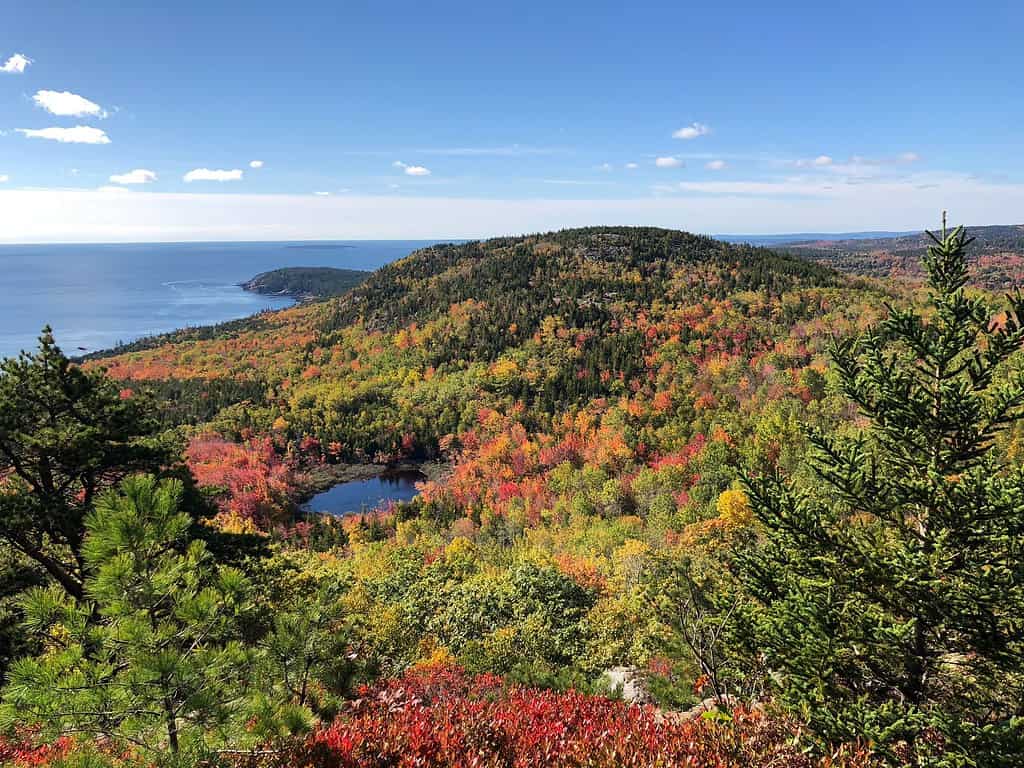
Trails & Activities
Hiking Trails
Activities
| Trail | Length (miles) | Elevation (ft) | Difficulty | Type |
| Precipice | 2.1 | 1053 | Challenging | Loop |
| Jordan Pond Path | 3.1 | 42 | Easy | Loop |
| Cadillac Mountain South Ridge | 6.7 | 1548 | Moderate | Out & Back |
| The Bubbles | 1.6 | 516 | Moderate | Out & Back |
| Ocean Path | 4.5 | 374 | Easy | Out & Back |
10. Denali National Park
Known for Denali, the tallest peak in North America.
Denali National Park, located in the heart of Alaska, is a vast, untouched wilderness known for its dramatic landscapes, rich wildlife, and the awe-inspiring Denali peak. Covering over six million acres, the park is larger than the state of New Hampshire. It showcases some of the most magnificent natural beauty in North America.
The park’s crowning glory is Denali, formerly known as Mount McKinley, which, at 20,310 feet, is the highest peak in North America. The mountain’s name, Denali, translates to “The Great One” in the local Athabascan language, befitting its grandeur.
Denali National Park’s landscape is a striking mix of tundra, spruce forests, glaciers, and snow-capped mountains. The park is intersected by a single, 92-mile-long road, offering extraordinary views and access to various hiking trails and campgrounds.
The park is a haven for wildlife, boasting a large, protected population of grizzly bears, caribou, Dall sheep, wolves, and a variety of bird species. In the skies above, golden eagles, peregrine falcons, and other raptors can often be seen.
From mountaineering and hiking to wildlife viewing, photography, and even dog sledding in winter, Denali National Park offers many experiences to connect with the wild. A journey into this remarkable park provides a sense of solitude, serenity, and adventure amidst one of the world’s most majestic landscapes.
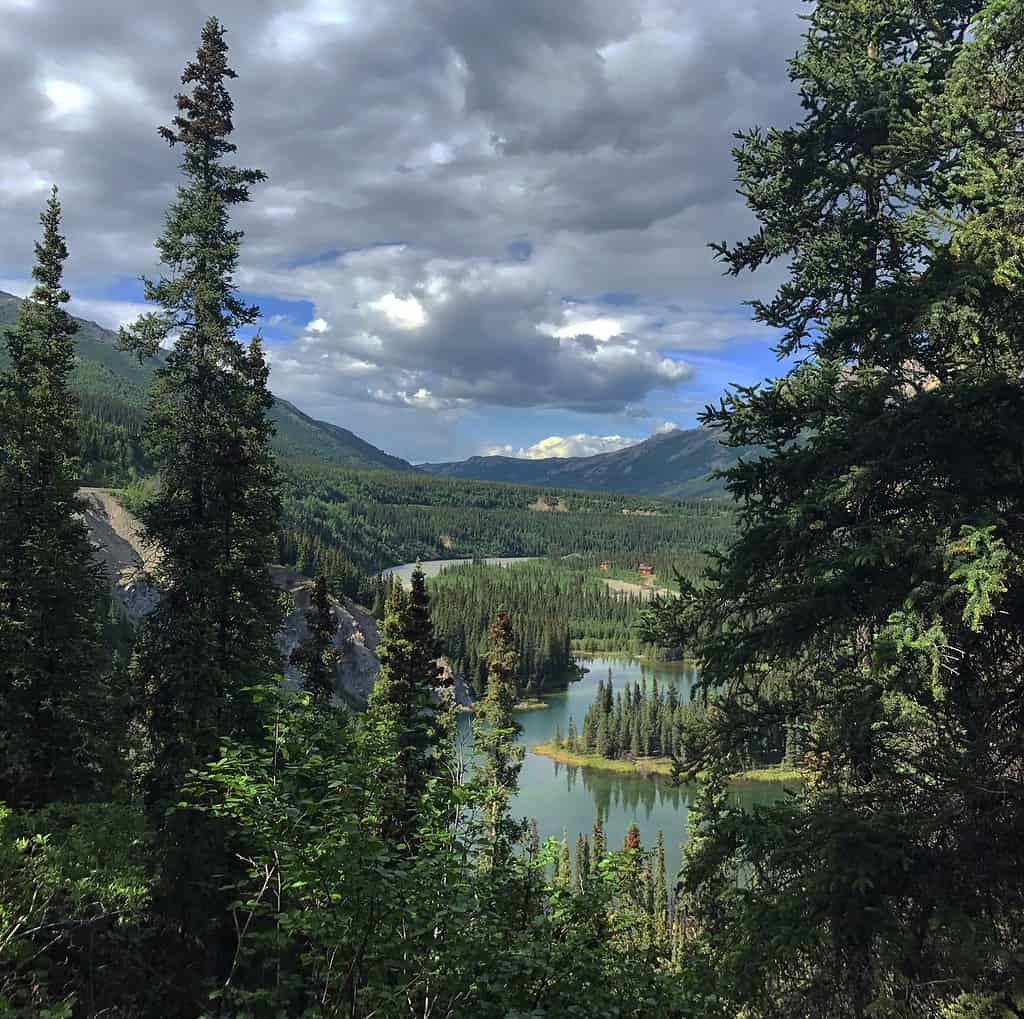
Trails & Activities
Hiking Trails
Activities
| Trail | Length (miles) | Elevation (ft) | Difficulty | Type |
| Savage River Loop | 2.1 | 459 | Moderate | Loop |
| Mt. Healy Overlook | 6.9 | 2483 | Challenging | Out & Back |
| Horseshoe Lake | 2.1 | 380 | Easy | Loop |
| Triple Lakes – South to North | 9.2 | 1830 | Challenging | Point to Point |
| McKinley Station | 3.2 | 446 | Easy | Loop |
11. Olympic National Park
Diverse landscapes from glacier-capped mountains to temperate rainforests and rugged coastline.
Olympic National Park in Washington State is a diverse and expansive wilderness encompassing nearly a million acres of breathtaking natural beauty. The park stands out for its diverse ecosystems, including glacier-capped mountains, over 70 miles of wild coastline, and lush, temperate rainforests.
One of the park’s most striking features is the Olympic Mountains, crowned by the majestic Mount Olympus, which stands at nearly 8,000 feet. The mountains are home to several glaciers and offer many hiking trails that provide stunning panoramic views.
The park’s Pacific coastline is a rugged, pristine landscape of rocky outcrops and tidal pools, interspersed with sandy beaches and dramatic sea stacks. This area is a paradise for beachcombing, bird watching, and exploring tidal life.
Equally impressive is the park’s lush Hoh Rainforest. It is one of the finest examples of temperate rainforests in the United States. Its moss-laden trees and dense vegetation create an almost otherworldly atmosphere, offering visitors a unique hiking and wildlife-viewing experience.
Olympic National Park is also renowned for its rich biodiversity, home to species like black bears, cougars, Olympic marmots, and a variety of bird species. The park’s rivers support several species of Pacific salmon and are critical habitats for these fish.
From hiking and backpacking in the park’s diverse landscapes to beachcombing along the wild coast, fishing in the rivers, and wildlife spotting, Olympic National Park offers a broad range of outdoor experiences, making it a true natural treasure.

Trails & Activities
Hiking Trails:
Activities:
| Trail | Length (miles) | Elevation (ft) | Difficulty | Type |
| Mt. Storm King | 4.1 | 2106 | Challenging | Out & Back |
| 5 Mile Island via Hoh River | 10.1 | 387 | Moderate | Out & Back |
| Sol Duc Falls Nature | 1.6 | 226 | Easy | Out & Back |
| Ozette Triangle Trail | 9.4 | 538 | Moderate | Loop |
| Staircase Rapids Loop | 2.1 | 213 | Easy | Loop |
12. Rocky Mountain National Park
Famous for its majestic mountains, diverse wildlife, and alpine tundra.
Rocky Mountain National Park, located in north-central Colorado, is a spectacular natural playground of over 265,000 acres. The park is characterized by its rugged beauty, diverse ecosystems, and, of course, the majestic Rocky Mountains.
At the heart of the park is the Continental Divide, making for dramatic changes in climate, flora, and fauna. The park boasts over 60 peaks that exceed 12,000 feet, the highest being Longs Peak at 14,259 feet, which provides challenging climbs and breathtaking views.
The park is renowned for its pristine alpine wilderness, lush forests, and stunning mountain lakes. Two of the most iconic lakes are Bear Lake, known for its accessible nature trail, and Dream Lake. These high-altitude gem rewards hikers with stunning vistas.
Rocky Mountain National Park is home to the montane and subalpine ecosystems, featuring a variety of wildlife, including elk, moose, black bears, mule deer, and bighorn sheep, among others. It also hosts a diverse range of bird species, making it a great bird-watching location.
The park features over 350 miles of hiking trails. These trails range from flat lakeside strolls to steep mountain peak climbs. Trail Ridge Road is the highest paved road in the U.S. It offers an extraordinary scenic drive, crossing the Continental Divide with panoramic views on both sides.
Whether hiking, wildlife viewing, camping, fishing, or simply soaking in the incredible mountain scenery, Rocky Mountain National Park is a stunning location that offers a variety of experiences for all outdoor enthusiasts

Trails & Activities
Hiking Trails
Activities:
| Trail | Length (miles) | Elevation (ft) | Difficulty | Type |
| Sky Pond via Glacier Gorge Trail | 8.6 | 1771 | Challenging | Out & Back |
| Emerald Lake Trail | 3.2 | 702 | Moderate | Out & Back |
| Deer Mountain Trail | 6.0 | 1394 | Moderate | Out & Back |
| Chasm Lake | 8.0 | 2552 | Challenging | Out & Back |
| Lily Ridge Trail | 1.1 | 193 | Easy | Loop |
13. Joshua Tree National Park
Famous for its rock formations and stark desert landscapes.
Joshua Tree National Park is located in southeastern California. It is a unique and diverse area where the Mojave and Colorado deserts converge. The park is over 1,200 square miles and is known for its stunning desert landscapes, iconic Joshua trees, rugged rock formations, and rich cultural history.
One of the park’s most defining features is the Joshua tree, a type of yucca that grows only in the Mojave Desert. These unique and gnarled trees give the park an almost otherworldly appearance. They are a sight to behold, particularly against a clear, star-filled night sky backdrop.
Joshua Tree National Park is also known for its rock formations. Created millions of years ago and shaped by strong winds and occasional rain, these formations are a paradise for rock climbers and boulders, with more than 8,000 climbing routes available.
The park hosts a variety of wildlife adapted to the desert environment, including desert tortoises, bighorn sheep, coyotes, and many species of birds and lizards. Springtime wildflower blooms can also add bursts of color to the desert landscape.
The park offers over 300 miles of hiking trails that take visitors through the contrasting environments of the Colorado and Mojave deserts, with highlights including the Hidden Valley, Barker Dam, and the Cholla Cactus Garden.
Joshua Tree National Park also holds cultural significance, with traces of the past seen in its petroglyphs, old mines, and homesteads. Whether you’re exploring its trails, climbing its rocks, stargazing, or delving into its history, Joshua Tree National Park offers an unforgettable desert adventure.

Trails & Activities
Hiking:
Activities
| Trail | Length (miles) | Elevation (ft) | Difficulty | Type |
| Hidden Valley | 1.0 | 118 | Easy | Loop |
| Ryan Mountain | 2.9 | 1062 | Moderate | Out & Back |
| Barker Dam Nature via Keys Ranch Road | 4.4 | 177 | Easy | Loop |
| Lost Palms Oasis | 7.5 | 1046 | Moderate | Out & Back |
| Boy Scout | 8.0 | 226 | Challenging | Point to Point |
14. Shenandoah National Park
Over 200,000 acres of protected lands filled with waterfalls and spectacular vistas.
Shenandoah National Park is located in Virginia’s Blue Ridge Mountains and is an eastern gem that covers around 200,000 acres of rolling landscapes, cascading waterfalls, and rich biodiversity. The park is long and narrow. The Shenandoah River and valley are on the west side. The rolling hills of the Virginia Piedmont are on the east.
At the heart of the park is Skyline Drive. Skyline Drive is a 105-mile road that winds along the crest of the mountains providing breathtaking vistas of the surrounding landscape. This scenic drive is particularly stunning when the park bursts into vibrant colors in the fall.
The park is known for its beautiful waterfalls, with over 70 within its borders. The highest, Whiteoak Canyon Falls, drops over 86 feet, and the trails leading to the various falls range from easy to challenging, offering something for every type of hiker.
Shenandoah National Park is a haven for wildlife, with over 200 species of birds for birdwatchers to spot and large mammals like black bears, deer, and bobcats that roam the park. It also hosts a variety of plant species, adding to the park’s rich biodiversity.
The park’s more than 500 miles of trails include a portion of the Appalachian Trail, providing ample opportunities for hiking, backpacking, and horseback riding. Whether exploring the beautiful waterfalls, trekking through its lush forests, or simply enjoying the views from Skyline Drive, Shenandoah National Park is a magnificent escape into nature.

Trails & Activities
Hiking
Activities
| Trail | Length (miles) | Elevation (ft) | Difficulty | Type |
| Old Rag Mountain Loop | 9.3 | 2595 | Challenging | Loop |
| White Oak Canyon | 9.4 | 2411 | Challenging | Out & Back |
| Dark Hollow Falls Trail | 1.6 | 583 | Moderate | Out & Back |
| Stony Man and Hawks Bill Loops | 12.9 | 2769 | Challenging | Out & Back |
| Bearfence Mountain Trail | 1.0 | 242 | Moderate | Loop |
15. Mount Rainier National Park
Home to wildflower meadows, ancient forest, glaciers, and Mount Rainier.
Mount Rainier National Park is located in Washington state. It is an alpine wonderland dominated by Mount Rainier, an active stratovolcano at 14,411 feet. This park covers 236,381 acres of wildflower meadows, ancient forests, and a glaciated peak, the most glaciated in the U.S.
Mount Rainier is the highest peak in the Cascade Range. It is the most recognized mountain in the lower 48 states and is the park’s star attraction. Whether challenging yourself with a mountaineering adventure to the summit or admiring its snow-capped grandeur from afar, Mount Rainier is a sight to behold.
The park’s diverse ecosystems include old-growth forests and subalpine meadows that burst with colorful wildflowers in the summer. Trails wind through these landscapes, offering a variety of hikes ranging from easy walks to challenging treks.
The park’s standout features are its glaciers and snowfields, making it a key destination for climbers. On the south slope of Mount Rainier, Paradise is the snowiest place on Earth, where snowfall is measured regularly, often receiving more than 50 feet of snow in a year.
The park hosts a rich variety of wildlife, including black bears, mountain goats, mule deer, and a variety of bird species. Its pristine rivers and lakes provide fish habitat and offer fishing and boating opportunities.
With over 260 miles of maintained trails for hiking, opportunities for climbing, skiing, camping, and wildlife viewing, Mount Rainier National Park offers a wide range of outdoor experiences in a stunning natural environment.

Trails & Activities
Hiking Trails
Activities
| Trail | Length (miles) | Elevation (ft) | Difficulty | Type |
| Skyline Trail Loop | 5.6 | 1771 | Moderate | Loop |
| Burroughs Mountain Trail Loop | 9.5 | 2601 | Challenging | Loop |
| Summerland to Owyhigh Lakes Loop | 14.6 | 1483 | Challenging | Loop |
| Glacier Basin Trail | 8.1 | 2345 | Moderate | Out & Back |
| Wonderland Trail | 85.8 | 24547 | Challenging | Loop |
16. Bryce Canyon National Park
Known for crimson-colored hoodoos, which are spire-shaped rock formations.
Bryce Canyon National Park, located in the southwest of Utah, is a spectacular landscape of geological wonders and a vibrant palette of colors. Despite its name, Bryce Canyon is a series of natural amphitheaters or bowls carved into the edge of a high plateau, not a single canyon, as some believe.
Bryce Amphitheater is the most famous, filled with a maze of eerie and beautiful rock formations called hoodoos. Hoodoos are tall, thin rock spires that protrude from the bottom of the basins and “broken” lands. The park has the largest concentration of hoodoos anywhere on Earth, making it a sight to behold.
Bryce Canyon’s striking red, orange, and white rocks create a stunning contrast against the clear blue sky. The play of light during sunrise and sunset adds another layer of magic to the already otherworldly landscape, casting a glow that makes the rocks appear on fire.
It has over 50 miles of hiking trails that weave through the hoodoos and overlooks. Popular trails include the Queen’s Garden Trail and the Navajo Loop Trail, which take you right among the towering hoodoos.
The park is also one of the best places for stargazing, thanks to its remote location and high altitude. On a clear night, you can see thousands of stars, the Milky Way, and several planets.
Bryce Canyon National Park offers a unique combination of geological curiosities, beautiful hiking trails, and some of the best night skies in the world, providing an unforgettable experience for all who visit.
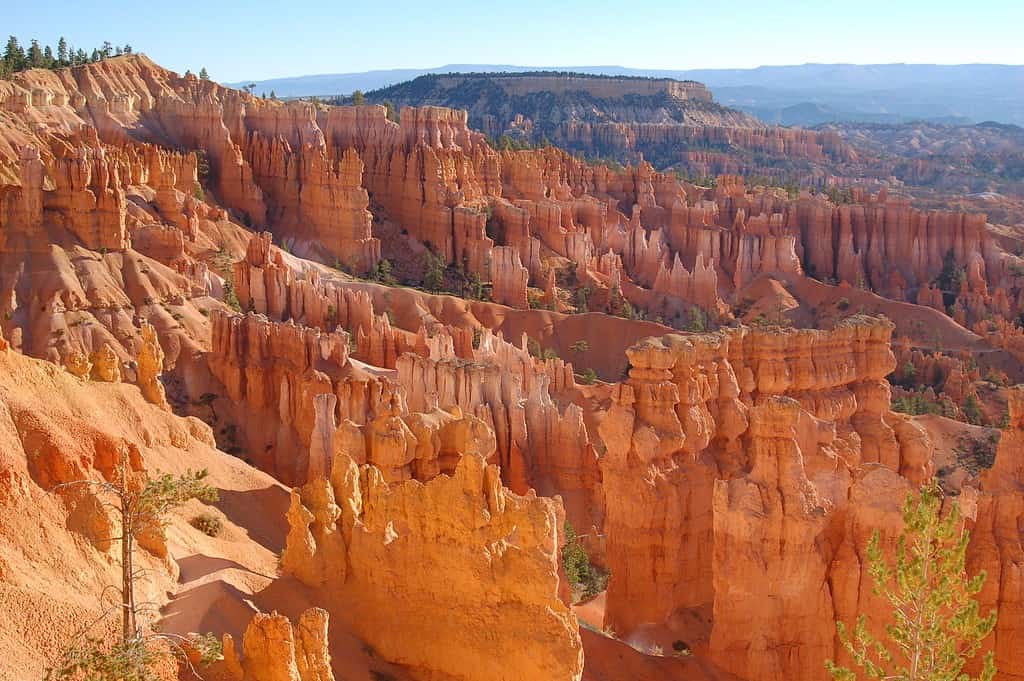
Trails & Activities
Hiking Trails
Activities
| Trail | Length (miles) | Elevation (ft) | Difficulty | Type |
| Navajo Loop | 1.5 | 515 | Moderate | Loop |
| Queens Garden Trail | 3.1 | 674 | Moderate | Loop |
| Fairyland Loop | 7.9 | 1558 | Moderate | Loop |
| Peekaboo Loop | 5.2 | 1528 | Moderate | Loop |
| Rim – to Lower Inspiration Point | 3.9 | 613 | Easy | Out & Back |
17. Sedona
Known for its mild climate, vibrant arts community, and red-rock buttes.
Sedona, Arizona, is an outdoor lover’s dream. It is renowned for its breathtaking red rock landscapes that glow a vibrant orange and red in the rising and setting sun. These sandstone formations are not only visually striking but are also known to be home to various vortexes, making Sedona a popular destination for spiritual seekers.
Surrounding Sedona are several National Forest lands, including Coconino National Forest, which offers many recreational activities. Visitors there can hike, mountain bike, or take a scenic drive through these stunning landscapes. Popular trails include the Cathedral Rock Trail and the Devil’s Bridge Trail, which offer incredible views.
Sedona is also well-known for Oak Creek Canyon. It is a river gorge often described as a smaller cousin of the Grand Canyon due to its scenic beauty. The area is abundant in waterfalls, swimming holes, and picnic spots.
While Sedona is not a national park itself, it offers easy access to several national monuments and parks, including Grand Canyon National Park, which is approximately two hours away by car.

Trails & Activities
Hiking Trails
Activities
| Trail | Length (miles) | Elevation (ft) | Difficulty | Type |
| Bell Rock Loop Trail | 1.8 | 203 | Moderate | Loop |
| Devil’s Bridge Trail | 3.9 | 521 | Moderate | Out & Back |
| Cathedral Rock Trail | 1.2 | 741 | Challenging | Out & Back |
| Boynton Canyon Trail | 6.1 | 826 | Moderate | Out & Back |
| Soldier Pass Trail | 4.5 | 839 | Moderate | Out & Back |
18. Adirondacks
Known for its extensive wild forest areas and outdoor recreation opportunities.
The Adirondack Mountains, often referred to as the “Adirondacks,” are a vast mountain range in northeastern New York State. They cover about 6 million acres, making it the biggest protected natural area in the lower 48 states of the U.S. The Adirondacks are known for their scenic beauty, diverse ecosystems, and abundant recreational opportunities.
The region boasts over 2,000 miles of hiking trails through dense forests, alpine meadows, and rugged peaks. 46 High Peaks in the Adirondacks rise over 4,000 feet, providing a significant challenge and reward for experienced hikers. Mount Marcy is the tallest among these, with an elevation of 5,344 feet.
But it’s not just about the mountains. The Adirondacks also feature over 3,000 beautiful lakes, ponds, and more than 1,200 miles of rivers, making it a paradise for water sports enthusiasts. There’s plenty to explore, whether you prefer canoeing, kayaking, or fishing.
Wildlife is abundant in the Adirondacks, with black bears, white-tailed deer, and beavers among the creatures that make their home here. Birdwatchers will be delighted by the diverse avian species, which include the iconic loon and various birds of prey.
With its rich natural beauty, numerous outdoor activities, and significant biodiversity, the Adirondack region offers a wilderness experience that can be as relaxed or thrilling as you want. Whether hiking up a High Peak, paddling down a tranquil river, or simply enjoying the forest’s peace, the Adirondacks are a fantastic destination for nature lovers and outdoor enthusiasts.

Trails & Activities
Hiking Trails
Activities
| Trail | Length (miles) | Elevation (ft) | Difficulty | Type |
| Mount Mercy Trail | 8.2 | 2667 | Challenging | Out & Back |
| Algoquin Peak & Wright Peak | 8.4 | 3651 | Challenging | Out & Back |
| Avalanche Lake | 10.2 | 1299 | Moderate | Out & Back |
| Cascade Mountain | 4.5 | 1906 | Challenging | Out & Back |
| Ampersand Mountain | 5.4 | 1765 | Challenging | Out & Back |
19. The Boundary Waters Canoe Area Wilderness
Known for its extensive interconnected lakes and rivers system.
The Boundary Waters Canoe Wilderness Area is a breathtaking and pristine natural paradise nestled in the northern region of Minnesota, United States. This expansive wilderness area spans over one million acres. It is renowned for its remarkable waterways, dense forests, and rugged beauty. It is a place where adventure and tranquility seamlessly blend, offering an unforgettable experience for outdoor enthusiasts and nature lovers alike.
The centerpiece of the Boundary Waters is its vast network of interconnected lakes, rivers, and streams. More than 1,200 miles of canoe routes meander through the area, inviting visitors to embark on incredible journeys of exploration and discovery. These crystal-clear waters reflect the surrounding wilderness, creating a picture-perfect setting that evokes a sense of serenity and awe.
As you navigate the waterways, you’ll encounter a diverse ecosystem teeming with life. Towering pines, spruces, and birch trees dominate the landscape, creating a canopy that shelters a rich variety of flora and fauna. Moose, deer, beavers, otters, and bald eagles are just a few of the species that call this region home, providing ample opportunities for wildlife sightings and photography.
It is a place where you can truly disconnect from the modern world. Cell phone service is limited, and motorized vehicles are prohibited, allowing for a truly immersive and unspoiled experience. This deliberate preservation of natural serenity allows visitors to connect with the environment on a deeper level, fostering a sense of introspection and appreciation for the wonders of the natural world.
The area offers a great variety of recreational activities that cater to outdoor enthusiasts of all skill levels. Canoeing and kayaking are the most popular modes of exploration, enabling visitors to glide through calm waters, navigate rapids, and portage between lakes. Fishing enthusiasts can cast their lines into the pristine lakes, hoping to catch walleye, northern pike, lake trout, or smallmouth bass. Hiking trails wind through the dense forests, offering breathtaking views and opportunities for wildlife spotting.
Camping is an integral part of the Boundary Waters experience. Scattered throughout the area are designated campsites where visitors can pitch their tents, enjoy a crackling campfire under a star-filled sky, and savor the tranquility of the wilderness. Camping here fosters a sense of self-reliance and respect for nature, as visitors are encouraged to practice Leave No Trace principles to maintain a pristine environment.
Whether you seek adventure, solitude, or a deeper connection with nature, the Boundary Waters Canoe Wilderness Area offers an unparalleled experience. Its pristine landscapes, shimmering waters, and abundant wildlife create a sanctuary where visitors can escape the demands of modern life and immerse themselves in the unadulterated beauty of the natural world.

Trails & Activities
Hiking Trails
Activities
| Trail | Length (miles) | Elevation (ft) | Difficulty | Type |
| Border Route Trail | 63.8 | 8331 | Challenging | Point to Point |
| Kekekabic Trail | 38.6 | 3416 | Challenging | Point to Point |
| Pow Wow – Pose Lake | 13.1 | 567 | Moderate | Out & Back |
| Snowbank Trail | 28.1 | 2388 | Challenging | Loop |
| Sioux Hustler Trail | 30.8 | 2814 | Challenging | Loop |
20. Isle Royale National Park
Isolated island park in Lake Superior.
Isle Royale National Park is a pristine and captivating wilderness refuge located in the northwest corner of Lake Superior, near the border of the United States and Canada. Its remote location and untouched landscapes make it a true gem of the National Park system. Covering an area of over 200 square miles, this secluded island offers a unique and immersive experience for nature enthusiasts, adventurers, and those seeking solace in the heart of the Great Lakes.
The centerpiece of Isle Royale National Park is its namesake island, which is the largest island in Lake Superior. The island is characterized by its rugged, rocky shoreline, dense forests, and inland lakes. Its undisturbed nature has allowed a wide range of wildlife to thrive, making Isle Royale a haven for biodiversity. Visitors may encounter moose, wolves, foxes, otters, beavers, and numerous bird species, including the iconic loons.
Exploring Isle Royale requires a sense of adventure, as the island has no roads or vehicles. Accessible only by boat or seaplane, the park has a remote and untouched allure. Once on the island, visitors can embark on a number of hiking trails that wind through the diverse landscapes. From challenging multi-day treks to leisurely day hikes, the trails offer glimpses of stunning vistas, secluded beaches, and hidden waterfalls.
One of the most unique features of Isle Royale National Park is its wolf and moose population dynamics. The island has been the subject of one of the longest-running predator-prey studies in the world, providing invaluable insights into the delicate balance of ecosystems. Observing or hearing the haunting howls of wolves or encountering a majestic moose in their natural habitat is a truly unforgettable experience.
The waters surrounding Isle Royale are also a draw for visitors. Lake Superior offers opportunities for kayaking, boating, and fishing. The clear, cold waters of the lake are home to a variety of fish species, including lake trout, salmon, and whitefish, attracting anglers from far and wide.
Camping is a popular activity on Isle Royale. Several campgrounds, including remote backcountry sites, provide opportunities to spend the night under the starlit skies and wake up to the serene sounds of nature. Permits are required for camping, ensuring the preservation of the island’s pristine condition and maintaining its wilderness character.
Isle Royale National Park is a place where time slows down, offering a respite from the fast-paced modern world. Its remote location, diverse ecosystems, and fascinating wildlife make it a truly unique and special destination. Whether you seek solitude, adventure, or a deeper understanding of the delicate balance of nature, Isle Royale National Park welcomes you with its untouched beauty and promises an unforgettable experience.

Trails & Activities
Hiking Trails
Activities
| Trail | Length (miles) | Elevation (ft) | Difficulty | Type |
| Greenstone Ridge Trail via East Chickbone Lake | 13.4 | 1053 | Moderate | Point to Point |
| Minong Ridge Overlook | 6.6 | 771 | Moderate | Out & Back |
| Scoville Point via Stoll Trail | 4.7 | 177 | Moderate | Loop |
| Mt Franklin via Tobin Harbor Trail | 9.8 | 705 | Moderate | Out & Back |
| Rock Harbor – Moskey Basin Campground | 21.3 | 1026 | Moderate | Out & Back |



